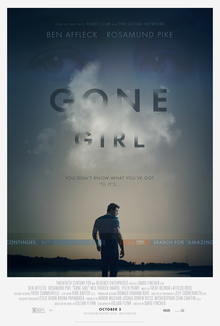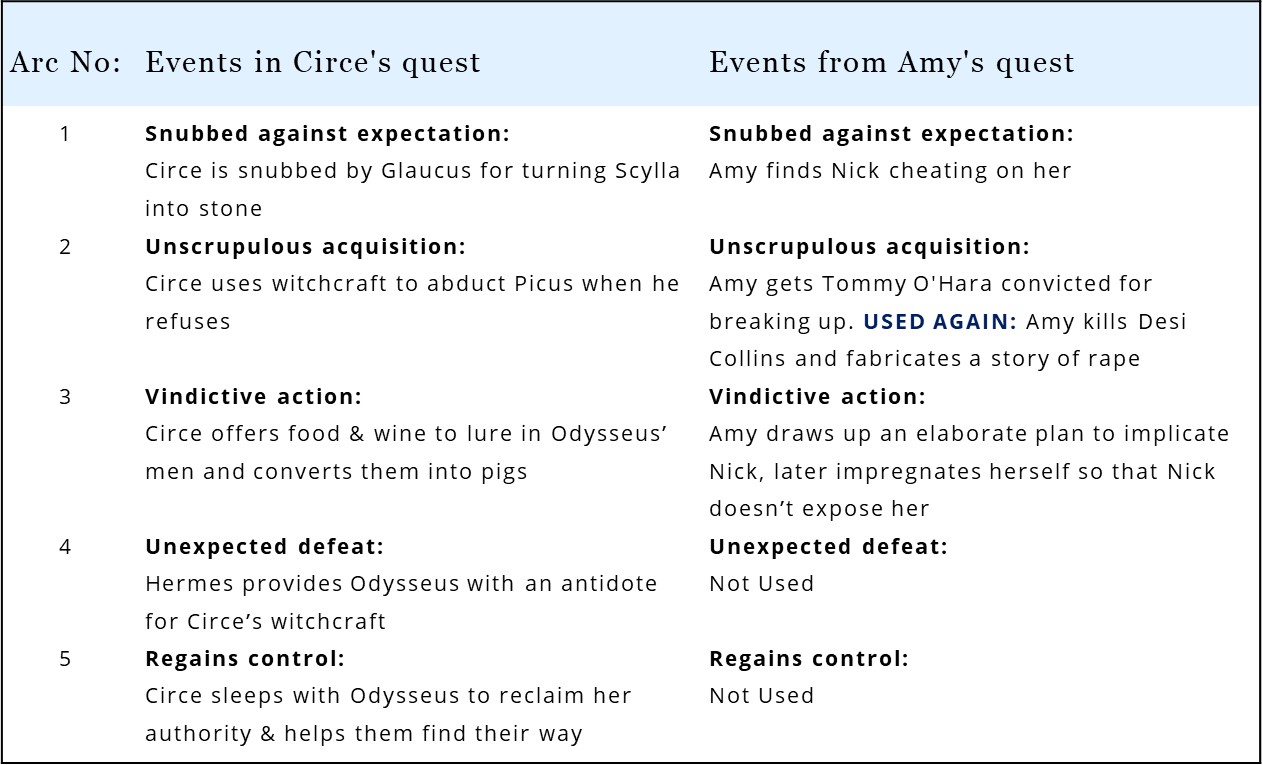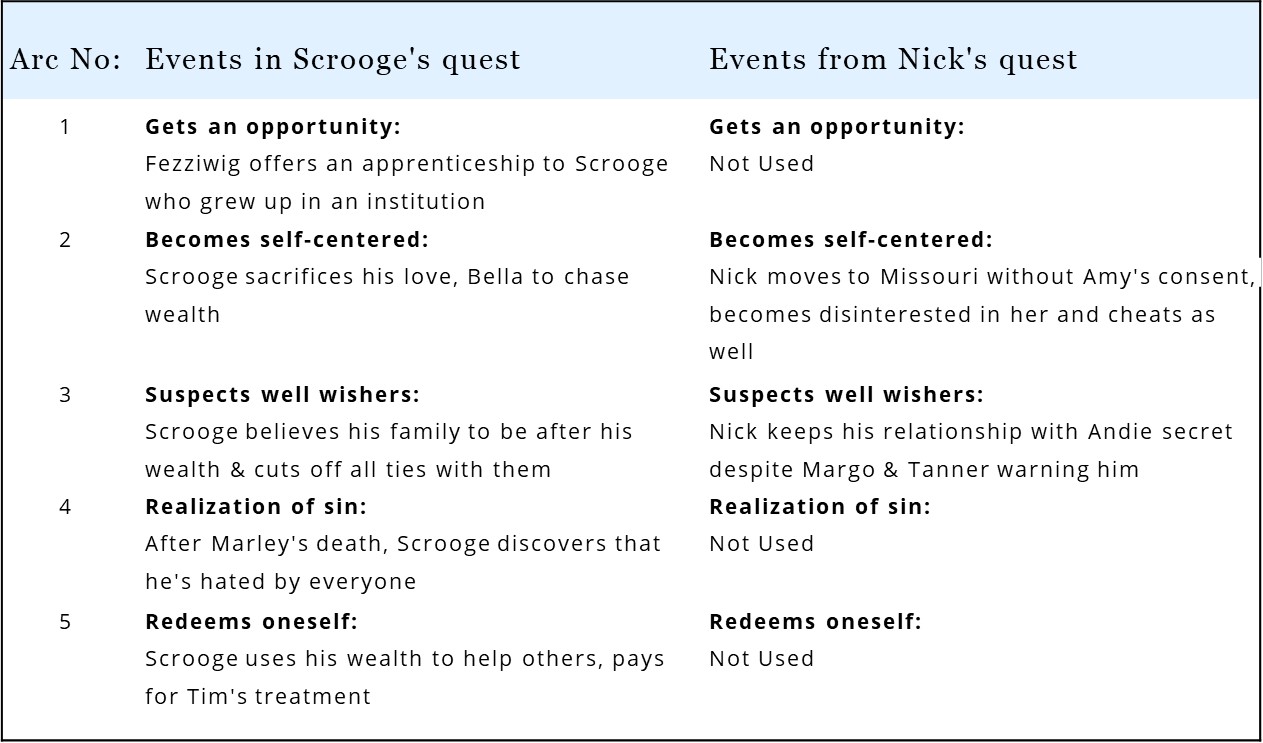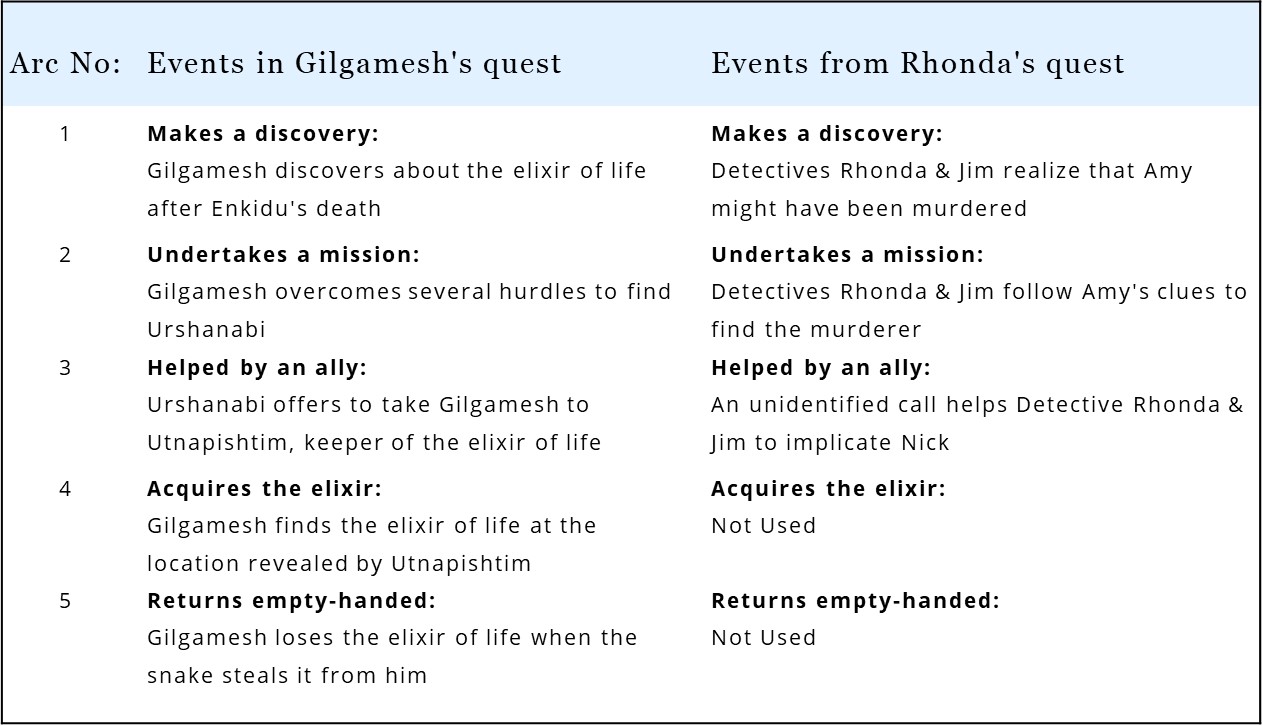Gone Girl… no wrath like a woman scorned

-
Est. vs Actual domestic box office revenue
$120-147MM/ $168MM - Three mythological tales reveal the invisible plot structure
Released in 2014, Gone Girl is directed by David Fincher and written by Gillian Flynn, based on her novel. The story is about a tumultuous marriage where the husband becomes the prime suspect for his wife’s disappearance. It explores basic human quests of power, accumulation and expedition. Mythosis uses 3 mythological tales to extract the plot structure of the movie.
1. Mythological tales reveal the invisible plot structure of any story
1A. 86% of the events are borrowed from 3 mythological tales
Amy’s quest is driven by the desire to dominate others and mirrors the tale of Circe from Greek mythology. Both Circe and Amy create a façade to entrap unsuspecting victims.
Nick’s quest is driven by the desire to collect unscrupulously and mirrors the tale of Valmiki from Hindu mythology. Both Valmiki and Nick are self-centered, even to the point of sacrificing their loved ones.
Rhonda's quest is driven by the desire for finding an elusive person/object and mirrors the tale of Gilgamesh from Sumerian mythology. Both Gilgamesh & Rhonda set out to find the “elixir of life”.
Detailed mirroring of each character to their respective mythological tales is in section “Unlocking the Ideal Plot Structure”
Nick’s quest is driven by the desire to collect unscrupulously and mirrors the tale of Valmiki from Hindu mythology. Both Valmiki and Nick are self-centered, even to the point of sacrificing their loved ones.
Rhonda's quest is driven by the desire for finding an elusive person/object and mirrors the tale of Gilgamesh from Sumerian mythology. Both Gilgamesh & Rhonda set out to find the “elixir of life”.
Detailed mirroring of each character to their respective mythological tales is in section “Unlocking the Ideal Plot Structure”
1B. 32 mythological tales are the source of all stories, even the untold ones
Human beings are driven by 16 fundamental desires. Every desire, whether encountering fulfilment or unfulfillment, gives rise to two distinct quests. Thus, a spectrum of 32 unique quests mirrors every human desire.
We have discovered mythological tales from across civilizations that uniquely portray each one of these 32 human quests. While each mythological tale stands as a distinct quest, the true magic unfolds when these tales are combined. This synergy is evident in the epics of Odyssey and Ramayan, where various universal quests seamlessly intertwine.
Combining any five tales from the 32, generates a staggering 24 million unique story plots. Take it a step further, by combining six tales the possibilities explode to an astounding 600 million!
The ideal plot structure of Gone Girl is # 17,871 that emerges from interweaving the universal quests of Power, Accumulation & Expedition.
We have discovered mythological tales from across civilizations that uniquely portray each one of these 32 human quests. While each mythological tale stands as a distinct quest, the true magic unfolds when these tales are combined. This synergy is evident in the epics of Odyssey and Ramayan, where various universal quests seamlessly intertwine.
Combining any five tales from the 32, generates a staggering 24 million unique story plots. Take it a step further, by combining six tales the possibilities explode to an astounding 600 million!
The ideal plot structure of Gone Girl is # 17,871 that emerges from interweaving the universal quests of Power, Accumulation & Expedition.
2. Plot structure potential of Gone Girl: $120-147MM
2A. Plot structure evaluation
An analysis of Blockbuster, Hit & Flop plots has led to the discovery of Mythosis Code. The Code reveals the story principles shared by all Blockbusters. We use the Code to estimate a story’s potential.
- All Blockbusters have at least 3 universal quests. Gone Girl uses 3 universal quests of Expedition, Accumulation & Power.
- In Blockbusters, each universal quest is mirrored by ONLY ONE character. Amy mirrors the universal quest of Power. Nick mirrors the quest of Accumulation. Rhonda mirrors the quest of Expedition.
- Every Blockbuster character borrows at least 35% of the universal quest. Amy borrows 44% from the universal quest of Power. Nick mirrors 22% from the universal quest of Accumulation. Rhonda borrows 9% from the universal quest of Expedition.
- Blockbusters interweave different quests to create a tight plot structure. Interweaving occurs when events of 2 quests occur simultaneously in the story. Blockbusters have a quest interweaving threshold of 0.5. Gone Girl has a quest interweaving score of 0.67 and is above par. An example of interweaving the quests of Amy & Nick:

2B. Estimating revenue potential of plot structure
Even though the plot structure of Gone Girl borrows from 3 mythological tales the 3rd quest is extremely shallow.
We have created an algorithm by assigning weights to the principles of The Mythosis Code. The algorithm calculates the potency of a story’s plot structure and estimates its corresponding audience appeal. Blockbuster plot structures have a score of at least 0.64 and appeal to 20% of the audiences.
Gone Girl has a script potential score is 0.16 and the movie will appeal to 4.63 – 5.66% of the population. Our estimate of the movie’s revenues from its audience appeal is $120 – 147MM in the domestic market. The movie’s actual revenue was $168MM.
We have created an algorithm by assigning weights to the principles of The Mythosis Code. The algorithm calculates the potency of a story’s plot structure and estimates its corresponding audience appeal. Blockbuster plot structures have a score of at least 0.64 and appeal to 20% of the audiences.
Gone Girl has a script potential score is 0.16 and the movie will appeal to 4.63 – 5.66% of the population. Our estimate of the movie’s revenues from its audience appeal is $120 – 147MM in the domestic market. The movie’s actual revenue was $168MM.
3. The ideal plot structure of Gone Girl
We have identified 32 universal quests that represent every human desire. These quests are the superset of thousands of stories across cultures that reflect our collective subconscious. Each quest has a structured sequence of events divided into 5 major arcs.
We map a character’s quest to the relevant mythological tale (universal quest) which reveals the gaps in their quest, if any. The ideal Plot Structure is constructed by plugging these gaps with the missing events from the tale. These events strengthen both the journey of characters as well as the weaving of quests without altering the story.
We map a character’s quest to the relevant mythological tale (universal quest) which reveals the gaps in their quest, if any. The ideal Plot Structure is constructed by plugging these gaps with the missing events from the tale. These events strengthen both the journey of characters as well as the weaving of quests without altering the story.
3A. Quest of characters and their mythological counterparts
Quest 1: Amy mirrors the universal quest for Power
Amy’s desire for Power stems from the need to dominate others. The tale of Circe from Greek mythology is the universal quest for Power.

Quest 2: Nick mirrors the universal quest for Accumulation
Nick’s desire for Accumulation stems from the need to collect & own. The tale of Valmiki from Hindu mythology has a robust expression in Dicken’s character of Scrooge which is the universal quest for Accumulation.

Quest 3: Rhonda mirrors the universal quest for Expedition
Rhonda’s desire for Expedition stems from the need to find an elusive person/object. The tale of Gilgamesh from Sumerian mythology is the universal quest for Expedition.

- Tags: 2014, 20th Century Fox, Accumulation, Blockbuster movies, Circe, David Fincher, Expedition, Gilgamesh, Gillian Flynn, Mythology, Plot Structure, Power, Prediction, Regency Enterprises, storytelling, TSG Entertainment, Valmiki
